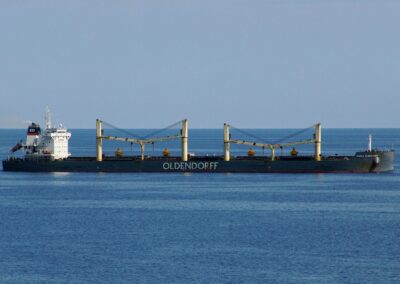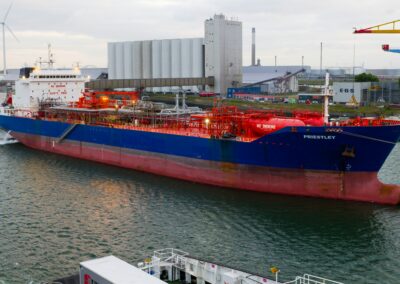Reduce your fuel consumption by 10 to 40%

Your stakes
On January 1, 2023, it became mandatory for all ships to calculate their existing ship energy efficiency index (EEXI), and to establish their operational carbon intensity indicator (CII) and CII rating.
By 2030, non-compliant ships will no longer be able to operate: the IMO has set ambitious targets of a 20% to 30% reduction in CO2 emissions by 2030, and neutrality by 2050.
To reduce emissions now, the shipping industry can play on a number of different solutions: from speed reduction to energy-efficient systems and the use of new fuels.
Our solutions
Compared with other wind propulsion technologies, rotor sails offer much greater thrust to propel the vessel per square meter of sail area. They can therefore be manufactured more cost-effectively and with less impact on vessel operation than traditional sails with a smaller deck footprint.
The Farwind rotor sail: one of the most efficient propulsion systems on the market.
Rotor sails: THE most suitable sailing propulsion system
A sea-proven concept for 100 years

A rotor sail is an active sail. It consumes a fraction of energy to convert the incoming wind into a powerful propulsive force. The physical principle – the Magnus effect – is the same as that used by a tennis lift.
The most widely used in the industry and certified on all types of vessels

Rotor sails are suitable for most types of vessel, whether new or retrofitted, bulk carriers, tankers, LNG and LPG carriers, ferries or ro-ro vessels.
Failsafe & fewer moving parts

The rotor sails comply with the highest marine quality standards and go into a safe position in the event of a fault. Thanks to their efficiency, less integration is required for a given power output, making better use of maintenance CAPEX.
Fully Automated and easy to handle

When the wind is favorable, the rotor sails automatically switch on and adjust the rotation speed to ensure maximum economy. The crew can also monitor rotor sail performance via the control unit.
OUR RANGE OF ROTOR SAILS
- Several patents have been registered.
- FARWIND Energy offers a range of rotor sails.
- FARWIND Energy has the ability to define a rotor adapted to a given vessel according to its structure, its routes and its specific constraints (such as air draft or operations).

Why Farwind rotor sails?
2.5 x more powerful than the second best
Our rotor-sails offer 2.5X greater lift than other propulsion technologies. The large dimensions of our sails give them the highest energy density per m² on deck in the world.
A better use of CAPEX

The large dimensions of our sails optimize integration and foundation costs for a given power output.
Foldable at sea and in port

In port, Farwind sails can be folded if required by air draft or loading operations.
This system can also be operated on the open sea, particularly in stormy conditions, requiring minimal crew intervention and ensuring the ship’s stability in all weathers.
Lightweight

Our rotor sails are made from lightweight, high-tech composite materials to deliver excellent performance while minimizing additional weight.
FIND OUT MORE ABOUT HOW ROTOR SAILS WORK
The wind ahead of the rotor sail is accelerated, pulled in the direction of the rotor’s rotation. This faster wind has a lower pressure, like the wind over an airplane wing (but up to 10 times lower).
Meanwhile, the wind behind the rotor slows down, causing the pressure to increase. This pressure difference pushes the rotor sail forward and propels the vessel. This auxiliary propulsion can be used to increase speed or reduce fuel consumption of the main engine.
Rotor sails are the most powerful of all sail types
For the same surface area, a rotor sail propels up to 10 times more than flexible sails.
According to the International Wind Ship Association, more than half of all wind-powered installations on commercial vessels over 5,000 tonnes worldwide are rotary sails.
FAQ
How much do rotor sails weigh?
The mass of FARWIND rotor sails is one of our differentiating features, thanks to a unique design and the use of high-tech lightweight composite materials, notably used in industries such as aeronautics.
At what angle to the wind does a rotor sail work perfectly?
Rotor sails are the most compact and powerful of all wind-powered systems. They harness the power of the wind better than any other sail system.
FARWIND rotor sails are managed automatically, and do not require the intervention of officers or sailors to operate and provide thrust.
A rotor sail propels the ship in a wide range of winds, from 15° to 180° true wind angle. Maximum thrust is reached around 100° true wind angle. Below 15° true wind angle, the control system minimizes the dunnage associated with the sails. True wind is the wind perceived by the ship, without taking into account its forward speed.
The most powerful rotor sail in the FARWIND range generates a thrust of 600kN at a ship speed of 15 knots, i.e. a propulsive power of 4.6MW.
Do rotor sails have an impact on visibility?
Safety and crew comfort are at the heart of the FARWIND design.
The choice of FARWIND rotor sail size is adapted to the vessel and to the layout of the sails on the upper deck.
Because rotor sails are very compact, they offer the lowest impact on visibility. Integration studies will ensure compliance with IMO regulations on bridge.
Do rotor sails affect the ship's stability and safety?
Rotor sails are suitable for and certified on most types of vessel.
All our designs are certified and approved by specialized certification companies, for operation in all conditions.
Key specifications such as stability and visibility are studied specifically for each vessel during the feasibility study phase.
How are rotor sails integrated into an existing vessel or a new build?
Rotor sails are suitable for integration on both existing and new vessels.
Integrating rotor sails at the design stage optimizes the ship’s structure and electrical architecture.
For existing ships, the integration of rotor sails typically enables fuel consumption to be reduced by between 10% and 40%, thus meeting IMO climate objectives.
Can FARWIND rotor sails be integrated anywhere in the world?
Yes, rotor sails are integrated on ships in two stages, which can be carried out sequentially or simultaneously.
These operations are carried out all over the world.
The first stage involves structural, electrical and electronic integration, and is carried out in a shipyard. At this stage, the area where the rotor sails will be installed is prepared.
The second stage can be carried out in a port, directly afloat, and corresponds to the installation of the sails themselves.
The ship is then ready to take free advantage of the wind available at sea.






